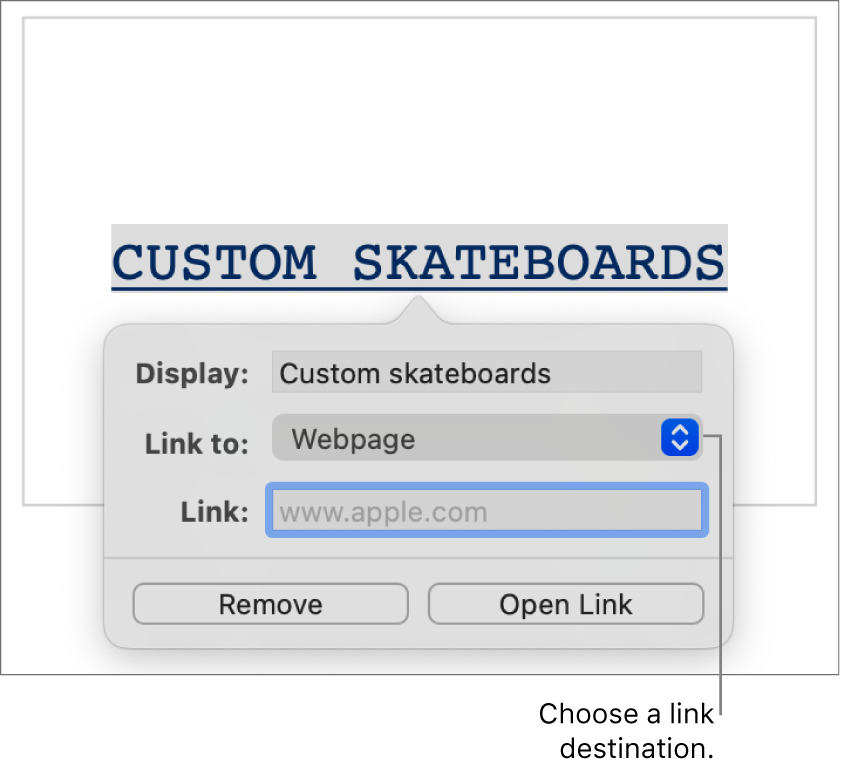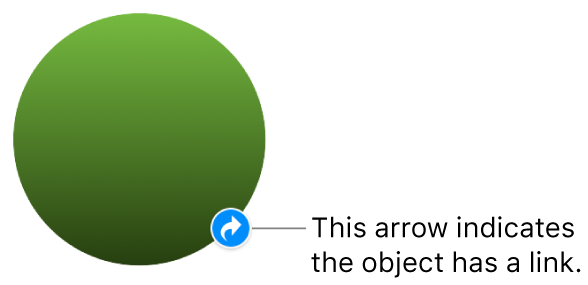
Link to a webpage, email, or slide in Keynote on Mac
You can turn text, text boxes, images, shapes, lines, arrows, and videos into links that you can click during a presentation to open webpages or email messages, jump to other slides, or exit the slideshow.
As you type text in a text box or shape, Keynote detects valid web addresses (URLs) and email addresses and styles them (for example, with an underline or different color) to indicate that they’re active links. If you don’t want Keynote to automatically detect links, you can turn off automatic link formatting.
Add a link
Control-click an object, text box, or selected text you want to turn into a link, choose Add Link, then choose a destination (Slide, Webpage, or Email).
Specify details for the destination:

Slide: Goes to another slide in the presentation. Choose one of the slide options or specify a slide number.
Webpage: Opens a webpage in a browser. In the Link field, enter the URL for the webpage. For a text link, in the Display field enter the text you want readers to see. For example, you may want to show the domain name and not the entire web address.
Email: Opens an email message preaddressed with the address you provide in the To field. For a text link, in the Display field enter the text you want readers to see. For example, you may want to show the recipient name and not the entire email address. Enter a subject in the Subject field or leave it blank.
Exit the slideshow: Ends the slideshow.
To verify the destination, click the Go to Slide, Open Link, or Compose Email button; otherwise, click the slide to close the link editor.

Linked text is underlined, and a link icon (it looks like a curved arrow) appears next to objects that are linked. The icon doesn’t show when you play your presentation.
Edit or deactivate a link
Click the linked text or the link icon on the linked object, or double-click a link in a table cell.
In the link editor, make your changes or click Remove.
When you remove a link, the link text is retained but the link formatting is removed and the link is no longer active.
When you’re finished, click the slide to close the link editor.
Turn off automatic formatting for links
If you don’t want Keynote to format website URLs and email addresses as active links, you can turn off automatic formatting.
Choose Keynote > Preferences (from the Keynote menu at the top of your screen).
Click Auto-Correction at the top of the preferences window.
In the Formatting section, deselect the “Automatically detect links” checkbox.
If you don’t want links to show formatting but you still want them to be active, select “Automatically detect links” and deselect “Automatically apply Link style.”
The setting applies to new text that you enter in all Keynote presentations. Existing links aren’t affected by the change.
You can set up your slideshow to be an interactive presentation that changes slides when the viewer clicks its links. An interactive, links-only presentation is especially useful in a kiosk setting.